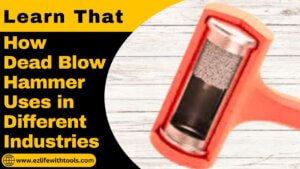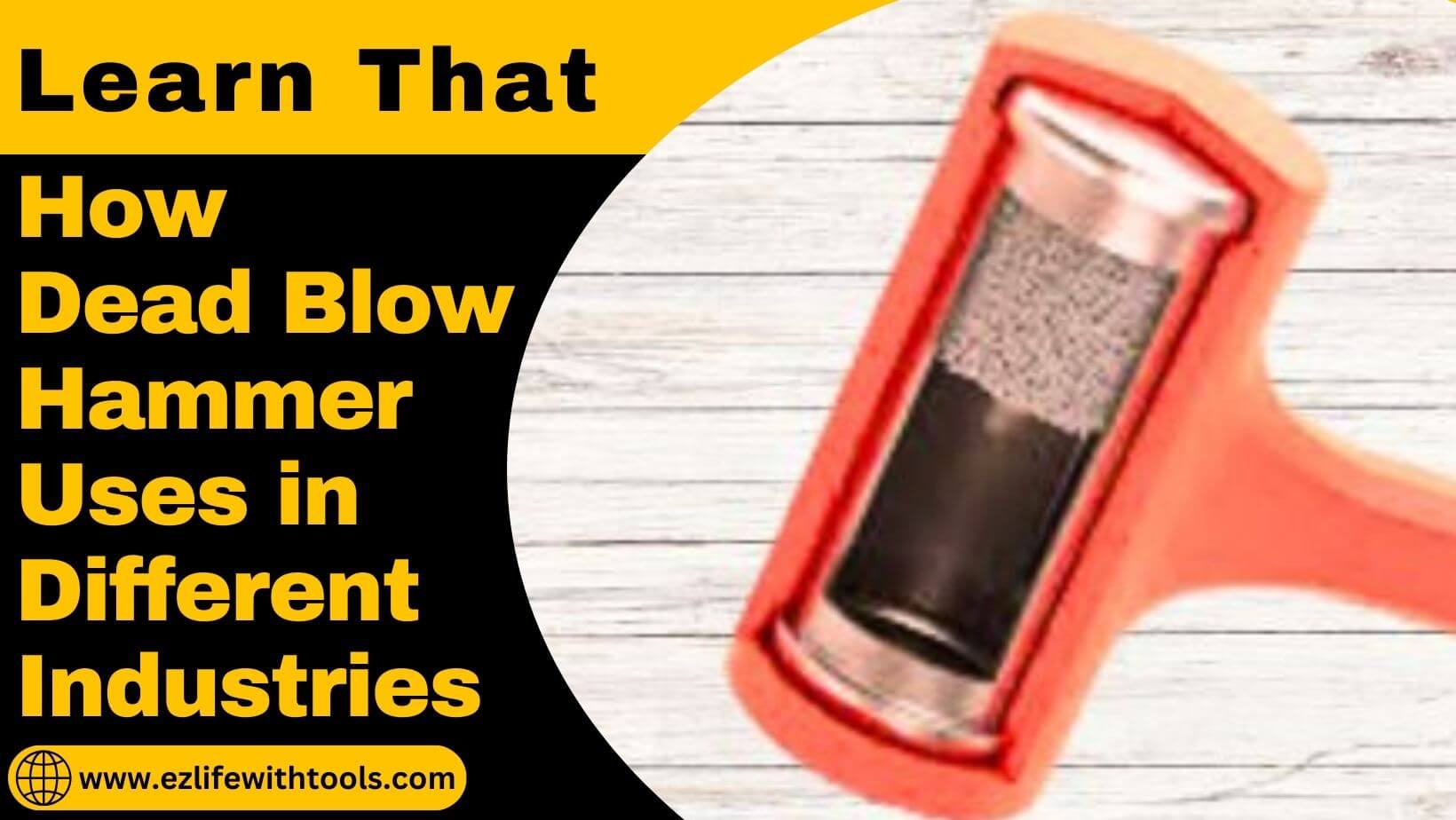Learn: How Dead Blow Hammer Uses in Different Industries

A dead blow hammer, a seemingly simple tool, holds remarkable versatility across multiple industries. Its unique design and functionality make it indispensable for various tasks.
From stubborn nail removal to delicate metal forming, this tool’s prowess lies in its ability to deliver controlled force without a rebound.
Exploring its uses and mechanics illuminates its significance in tasks requiring precision and impact.
Let’s delve deeper into the world of dead blow hammers to uncover their diverse applications and why they are an essential addition to any toolkit.
So, keep reading.
Dead Blow Hammer’s Mechanics
The key feature of a dead blow hammer lies in its internal mechanism. When you strike the hammer on an object, the internal filling moves within the head, absorbing and distributing the force evenly.
As a result, the hammer delivers a controlled and powerful blow without the usual bounce-back than conventional hammers.
This feature not only enhances precision but also reduces the risk of damaging delicate surfaces or injuring the user due to unexpected recoil.
Industries Where Dead Blow Hammer Uses
Dead blow hammers are suitable for different tasks in various industries.
Understanding their practical uses unveils their usefulness to achieve precision, controlled impact, and versatility in completing different projects.
- Automotive
- Woodworking
- Carpentry
- Machine Manufacturing
- Metalworking
1- Automotive
Bodywork and Panel Adjustments: In automotive repair and bodywork, dead blow hammers aid in aligning panels without causing further damage to the vehicle’s surface.
Their controlled impact helps technicians achieve precise adjustments.
Removing Stubborn Bolts: In automotive repair, there are often nuts and bolts that seem stuck due to loosen or rusted.
Parts Installation: Mechanics use dead blow hammers in tasks related to the vehicles, like hubcap installation, transmission work, suspension systems, and steering components.
It also includes diagnosing issues, replacing worn-out parts like shocks or tie rods, and ensuring the vehicle’s handling remains safe and smooth.
2- Woodworking
Precise Woodworking Tasks: Woodworkers utilize dead blow hammers for tasks such as setting delicate wooden joints, driving wooden pegs, or adjusting wooden components. The controlled force prevents splitting or damaging the wood.
Flooring: In flooring projects, dead blow hammers help in installing laminate or hardwood flooring by gently tapping pieces into place without damaging the material or surface finish.
Carving and Chisel Work: When working on delicate carving or chiseling tasks, dead blow hammers offer a controlled strike. They help to apply force without the risk of damaging the carving or the chisel itself. This precision helps to make clean, accurate cuts.
3- Carpentry
Installing or Removing Nails: Whether you’re driving nails or removing them, dead blow hammers provide the necessary impact without damaging surfaces. They allow for controlled strikes to drive nails without leaving unsightly marks or to gently remove them without causing unnecessary destruction.
Adjusting Frame and Alignment: In construction, maintaining precise alignment is vital. Dead blow hammers come in handy for adjusting frames or structures without causing damage. They’re great for nudging components into alignment without risking structural integrity.
4- Machine Manufacturing
Precision Assembly: In manufacturing processes, dead blow hammers aid in the assembly of delicate machine components. Their controlled force assists in aligning and seating parts without causing damage.
5- Metalworking
Shaping and Forming Metals: Metalworkers rely on dead-blow hammers to shape and form metal components without leaving marks or deforming the material. Their controlled impact is crucial for delicate metal manipulations.
Delicate Metal Work: In metalworking, dead blow hammers aid in shaping or forming metals without causing surface marring or deformation. Their controlled impact allows for precise manipulation of metal parts.
Additional Dead Blow Hammer Uses
You have already learn about big industries where Dead blow hammer uses effectively. Here we will explain some additional uses of dead blow hammer.
Safety in Emergencies: Dead blow hammers can be used in emergency situations to shatter glass. Their controlled impact helps break tempered glass in vehicles or buildings, enabling safe exits during accidents or crises.
Demolition Tasks: For breaking or dislodging stubborn or fragile objects, dead blow hammers offer controlled force, minimizing collateral damage and ensuring a more precise impact on the intended target.
Powerful Yet Manageable: Despite their effectiveness in delivering force, dead blow hammers are typically lighter than their solid counterparts, making them easier to handle and reducing user fatigue during prolonged use.
Safety Tips for Dead Blow Hammer Uses
Safety should be the first priority in any project because safety guidelines minimize the risk of accidents and maximize the effectiveness of the tool for various tasks.
Please follow these guidelines.
Wear Safety Gear: Always remember to use some appropriate safety gear like gloves and goggles when using a dead blow hammer. These safety tools provide essential protection against such hazards.
Proper Force Application: Dead blow hammers are designed to deliver controlled force. Avoid using excessive force when striking objects.
Excessive force may not only lead to inefficient use of the tool but could also cause damage to the hammer or the target surface.
Suitable for Short, Precise Tasks: Dead blow hammers are ideal for short, precise tasks requiring controlled impact.
They excel in scenarios such as driving or removing small nails, aligning components, or tapping delicate materials where precision is crucial.
Storage Tips: Store dead blow hammers in a dry and clean environment when not in use. Ensure they are placed in a way that prevents damage to the head or handle.
Proper storage prolongs the lifespan of the tool and maintains its effectiveness.
Advantages and Disadvantages of Dead Blow Hammer Uses
Awareness about the advantages and disadvantages of dead blow hammers helps you in decision-making about their use in different projects.
Advantages
The primary advantage of dead blow hammers is their ability to deliver controlled force without a rebound. This feature minimizes the risk of damaging surfaces or materials.
Dead blow hammers are lightweight than solid hammers and reduce strain on the user’s arms and wrists during prolonged use.
Disadvantage
- Dead blow hammers are not suitable for heavy-duty tasks which require excessive force or power.
- Continuous or misuse of dead blow hammers may lead to wear of the internal damping mechanism, which can affect their efficiency over time.
- These are more expensive than solid hammers.
Conclusion
Dead blow hammers, with their unique design and versatile applications, stand as indispensable tools in various industries and projects.
Their ability to deliver controlled force without rebound makes them invaluable for tasks requiring precision and impact.
The exploration of these hammers’ mechanics, safety guidelines, practical uses, and industry applications underscores their significance in achieving efficient and controlled striking capabilities.
Embracing their capabilities and recognizing their applications across diverse industries ensures their place as essential tools in any professional or DIY toolkit, elevating efficiency, precision, and safety in various tasks.
Thank you for your time.
Best wishes
Frequently Asked Questions
What is the dead blow hammer used for?
It is used for those tasks requiring impact without rebound, like driving stakes, adjusting machinery components and tapping delicate surfaces.
Do I need a dead blow hammer?
Whether you need a dead blow hammer depends on your specific tasks. It’s beneficial for minimizing surface damage and reducing rebound, particularly in delicate or precise work.
Can you use a dead blow hammer for flooring?
Yes, you can use it for flooring, because it helps to minimize the surface damage and ensure secure flooring tasks.
How heavy should a dead blow hammer be?
The weight can vary depending on the task and personal preference. Common weights range from 1 pound to 4 pounds for general-purpose use.
Are dead blow hammers better?
Dead blow hammers offer advantages like reduced rebound, minimized surface damage, and improved accuracy compared to traditional hammers, making them better for certain tasks and delicate materials.

